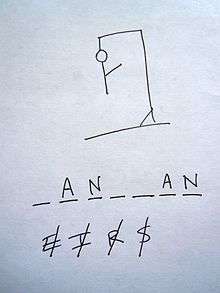Hangman (game)

Hangman is a paper and pencil guessing game for two or more players. One player thinks of a word, phrase or sentence and the other tries to guess it by suggesting letters or numbers, within a certain number of guesses.
Overview
The word to guess is represented by a row of dashes, representing each letter of the word. In most variants, proper nouns, such as names, places, and brands, are not allowed. If the guessing player suggests a letter which occurs in the word, the other player writes it in all its correct positions. If the suggested letter or number does not occur in the word, the other player draws one element of a hanged man stick figure as a tally mark.
The player guessing the word may, at any time, attempt to guess the whole word. If the word is correct, the game is over and the guesser wins. Otherwise, the other player may choose to penalize the guesser by adding an element to the diagram. On the other hand, if the other player makes enough incorrect guesses to allow his opponent to complete the diagram, the game is also over, this time with the guesser losing. However, the guesser can also win by guessing all the letters or numbers that appears in the word, thereby completing the word, before the diagram is completed.
Variants
As the name of the game suggests, the diagram is designed to look like a hanging man. Although debates have arisen about the questionable taste of this picture,[1] it is still in use today. A common alternative for teachers is to draw an apple tree with ten apples, erasing or crossing out the apples as the guesses are used up.
The exact nature of the diagram differs; some players draw the gallows before play and draw parts of the man's body (traditionally the head, then the torso, then the arms and legs one by one). Some players begin with no diagram at all, and drawing the individual elements of the gallows as part of the game, effectively giving the guessing players more chances. The amount of detail on the man can also vary, affecting the number of chances. Some players include a face on the head, either all at once or one feature at a time.
Some modifications to game play (house rules) to increase the difficulty level are sometimes implemented, such as limiting guesses on high-frequency consonants and vowels. Another alternative is to give the definition of the word; this can be used to facilitate the learning of a foreign language.
History
"The origins of Hangman are obscure meaning not discovered, but it seems to have arisen in Victorian times," says Tony Augarde, author of The Oxford Guide to Word Games. The game is mentioned in Alice Bertha Gomme's "Traditional Games" in 1894 under the name "Birds, Beasts and Fishes." The rules are simple; a player writes down the first and last letters of a word and another player guesses the letters in between. In other sources, the game is called "Gallows", "The Game of Hangin'", or "Hanger".
Strategy
In the English language, the twelve most commonly occurring letters are, in descending order: e-t-a-o-i-n-s-h-r-d-l-u. This and other letter-frequency lists are used by the guessing player to increase the odds when it is their turn to guess. On the other hand, the same lists can be used by the puzzle setter to stump their opponent by choosing a word which deliberately avoids common letters (e.g. rhythm or zephyr) or one that contains rare letters (e.g. jazz).
Another common strategy is to guess vowels first, as English only has five vowels (a, e, i, o, and u, while y may sometimes, but rarely, be used as a vowel) and almost every word has at least one.
According to a 2010 study conducted by Jon McLoone for Wolfram Research, the most difficult words to guess include jazz, buzz, hajj, faff, fizz, fuzz and variations of these.[2]
Derivations
The game show Wheel of Fortune is based on Hangman, but with the addition of a roulette-styled wheel and cash awards.
Example game
The following example game illustrates a player trying to guess the word hangman using a strategy based solely on letter frequency.
| 0 | 
| ||||||
| 1 | 
| ||||||
| 2 | 
| ||||||
| 3 | 
| ||||||
| 4 | 
| ||||||
| 5 | 
| ||||||
| 6 | 
| ||||||
| 7 | 
| ||||||
| 8 | 
| ||||||
| 9 | 
| ||||||
| Guesser loses - the answer was HANGMAN. | |||||||
References
- ↑ Foreign English Teacher Under Attack For Playing Hangman Game, Japan Probe, July 23, 2010
- ↑ McLoone, John (13 August 2010). "Jon McLoone 25 Best Hangman Words". Wolfram Research. Archived from the original on 15 August 2010. Retrieved 14 March 2015.
External links
- 25 Best Hangman Words Analysis of Hangman tactics at Wolfram.com
- Browser-Based Hangman Games at DMOZ